The Altars Which Found Us
– by Sarah Sao Mai Habib
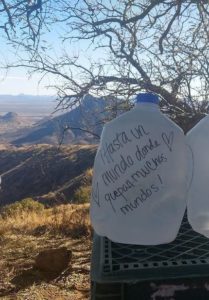
December 2020.
We are living in a medical aid camp, mostly made of tent structures and a few trailers. We are a collective staffing this small space near the so called US/Mexico border in the Sonoran desert. The nights here are below freezing and we are surrounded by mesquite, cactus, javelinas and constant surveillance. Because the border is heavily militarized by border patrol (BP) and xenophobic white supremacist militia, the aid camp felt like a humble attempt at a safer space in a war zone. We were warned that camp was violently raided by BP and can be again. This type of war has no set location, seeping wide into all aspects of border communities. Migrants often came in hungry, dehydrated, fatigued, injured and separated from their group.
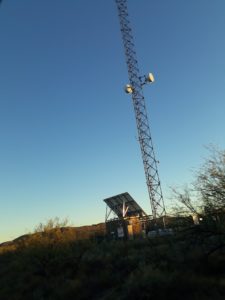
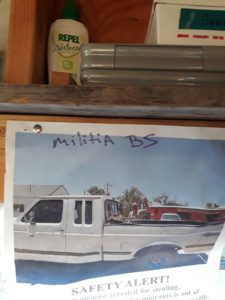
It is impossible to separate the issues of diasporic, Indigenous, Black, refugee and other communities here. They all intersected & heightened at this manufactured border. It wasn’t just Central and South American natives who were crossing, but many people from across seas as far as Asia found themselves at this very border. Most are fleeing impossible circumstances of harmful & violent political, social, ecological, and economic crisis, caused by the confluence of systemic oppression, namely settler colonialism, imperialism & racial capitalism.
Right alongside this reality, there was still laughter at this camp, still midnight cafecito requests, and fireside chats, getting to know one another, where we come from and our hopes. There was still colorful fashion, thanks to the ropa tent and some of the flamboyant jackets that were donated (not popular for the treacherous journey due to surveillance, but donned at camp dinners). There was still music, birthday celebrations, prayer and offerings to the communal altar. I got to practice the art of body language more consciously, like the head nods, and full bodied smiling because we were always masked due to COVID19, and because of my limited language. I mostly listened and felt closer to quiet & presence during this time. I took refuge in the small everyday roles of camp maintenance, cooking, cleaning, collective strategizing, protection and learning. I felt the mutual support & strength of the beings around me, migrants, staff, volunteers, and land alike.
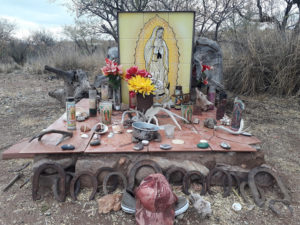
What are we maintaining? Why? How? And for whom?
During this month, I am witness to two contrasting forms of maintenance: the maintenance of separation & fragmentation, and the maintenance of wholeness & dignity. I am also witness to the contrast of institutional & financial support that each receives. When I think of maintenance, I think of “supporting the continuation of :.….”.
Then I ask: what are we supporting the continuation of? Why? For whom? And how? These are the big picture questions I feel a responsibility to ask, calling consciousness to the specific context I am living in: a time and space of ongoing US settler colonial occupation of native land, which has enabled imperialism abroad. And within a time of global pandemic that has made absolutely undeniable the ways systemic power structures influence our wellbeing and continuation, as well as how our personal actions have serious impacts on collective health. My work is scalar, and for me to engage maintenance on the physical scale, I am also engaging maintenance on the scales of value systems, collective agreements, cultures and ways of being. After all, we labor to maintain what is outside of ourselves, whether it is physical infrastructure, invisible norms, or communal bonds, in an effort to maintain ourselves.
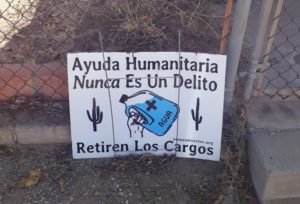
September 2001.
I’m twelve years young in Vietnam, visiting my mother’s ancestral homelands, which she was forced to leave in the 70s due to the US/Vietnam war. The spectrum of local responses to the 9/11 tragedies would take me many years to even start to grasp. This is the year that many of us lose a type of innocence. Whether we lost loved ones, or knew of people affected directly or indirectly, we were all changed. My most vivid memory aside from waking up to what I thought was a horror movie trailer, was how I was treated at airports (another site of border crossing) at 12 and visibly still a child, pulled aside and patted down as if I could be strapped. This is the beginning of the “war on terror”.
What are we remembering? Why? How? And for whom?
A very brief and very incomplete timeline: settler colonialism here enables imperialism abroad:
1492 Turtle Island invaded by Columbus. Trans Atlantic slave trade.
1600s European colonial settlements.
1680 Pueblo revolt.
1790s/1880s Haitian revolution. Chinese Exclusion Act.
1950s/60s/70s Civil rights movements. Vietnam war. Mỹ Lai massacre.
1970/80s Continued US “Interventions” in Central & South America
1990s Gulf war. NAFTA. Prevention Through Deterrence.
2000s 9/11. Afghan war. DHS. Patriot Act. Operation Streamline.
2020s Global Black Lives Matter uprisings & uncovering of mass unmarked graves at Native American boarding schools. Atlanta shootings targeting Asian communities on anniversary of Mỹ Lai massacre. Demolition of Palestian homes on Nakba anniversary.

December 2020.
My comrade & I decided the day before that despite needing to quarantine together, we would still go out into the desert for water & supply drops. We conducted a truck check, loaded it up with water, beans, & winter survival supplies. We double-checked batteries for the gps, and made sure we knew how to use a few different models. We studied maps that I’m guessing hundreds of people helped draw, write descriptions for and maintain. We chose one specific route not really knowing what it would come to mean to us. After a long day of driving on rugged desert terrain, navigating, hauling and placing supplies on migrant routes, we hike towards our last stop. This is when the altar found us, dedicated to Josseline, a teenage girl who lost her life on the border crossing journey to her family further north. The altar was simple, dressed in beads, crosses, cowrie shells, candles and freshly picked barrel cactus fruit. We stood and knelt there, in silence, prayer and intention. I’m thankful for this altar and the others who called to us this year. I think of all the altars of this summer, the ones honoring Black & Brown lives lost to systemic violence, the ones for lives lost to COVID19, and the family altar my grandmother tended to and was in conversation with til her last breath.
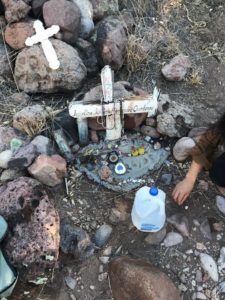
They called on us to be created or conversed with, as a way to grieve, express love, and ask for guidance. Altars embody a connection to the unseen, between this world and the spirit world. They are living memory keepers, who change with our interaction with them, and who conversely change us. We nourish altars and are nourished by them. They are not always elaborate or immediately noticeable but hold both respect for death & affirmation for life. They are a sort of ancestral architecture that is a vessel for the sacred, and a space to give and receive spiritual stamina.
These architectures of grief, remembrance, gratitude, and connection strongly contrast the architecture of amnesia, denial & separation of the border wall. Along the Sonoran mountains and near major highways, a tall massive metal wall was being dug into the ground, ripping into sacred lands of the O’odham, and depleting precious desert water. The wall is just one of BP’s “prevention through deterrence” strategies, which acts to funnel migrants to more rural and dangerous areas of the desert. “Prevention through deterrence” has manufactured & exacerbated unnecessary deaths, extraction, and exploitation of people, plants, animals, water, minerals, and land.
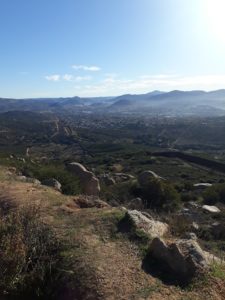
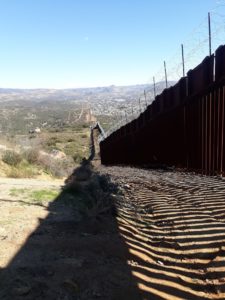
2021
Twenty years have passed since “the war on terror” and the beginning of the war in Afghanistan. The US government decides that this is the year to finally end that war and within a day the capital – Kabul falls, leaving us to ask: how much “nation building” was actually happening in the last two decades? Back at the so called US/Mexico border, vehicle barriers block Tohono O’odham families from gathering & ceremony. Their homelands have included both sides of the US/Mexico border before either nation formed. Just last year, Kumeyaay and Hia Ced water, land and ancestral burial protectors put their bodies on the line to block border wall construction. Some still face federal charges to this day. Haiti gets hit by another devastating earthquake, causing many to escape towards the US, traversing land and water, only to be met by whips and forced repatriation back to the dangers they were seeking refuge from. There are so many other communities, and their stories that I won’t be able to share & give justice to here, who have lived and are living through the effects of hyper militarized border violence. The irony is that the borders were & are weaponized in pre and especially post 9/11 era in deadly ways to justify a US colonial imperial military reach that is virtually borderless.
The daily threshold crossings of last winter were not lost on me. It was the same machine forcing people to make the dangerous journey across Sonoran terrain, that drove my mother and her family to flee Vietnam, is the same machine that made my parents flee Kuwait during the Gulf war. The language of borders is written in my blood, making me not of the machines of fragmentation, but a living embodiment of a bridge being, and kin to all other bridge beings.
This year, the multiplicity of the scales of time and space were illuminated. This year, many of us faced our traumas with a lot less distractions than usual. This year, I understood on a deeper level how trauma warps the dimensions of time, space & memory.
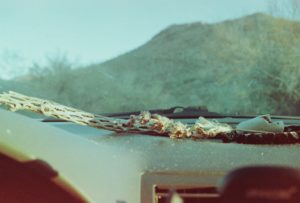
Trauma is too soon, too fast, too much. Trauma is fragmentation, splicing our sense of wholeness. Trauma is inherently tied to the body. And the body is inherently tied to land. When systems of oppression strategically sever us from land, trauma occurs. When systems of oppression strategically sever us from cultural practices & memory rooted in a sense of home & place, trauma occurs. We can not talk about repair & healing without talking about being trauma-informed & allowing trauma affected communities to lead their own healing process.
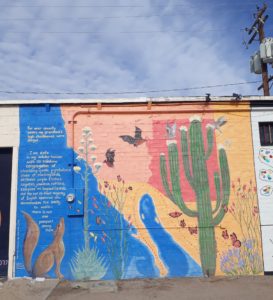
The border wall in contrast with altars represents just one way the contrast of our commitments takes shape in physical form. Are we committed to exploitation, violence & the denial of our interconnectedness? Or are we committed to devotional nurturing, connection, and trauma-informed healing? It is indicative that many who do make it across the border alive, become the backbone & maintainers of the new communities they find themselves in. It is important to acknowledge how many undocumented folks work vital service jobs, exploited due to both the factors that drove them to migrate and citizenship status.
The border walls in contrast with the altars also represent the contrast of colonial technology versus ancestral liberatory technology. Colonial technology and “innovation” rely on the perpetuation of dysfunction. For border walls, military-grade equipment, and extractive technologies to mean anything, society must still be warring, must still be reliant on a way of life that depends on depleting the earth, and must still be in denial of all species’ earth right to migration. Ancestral technologies should not be relegated to static traditionalism, but rather acknowledged and respected as dynamic, actively relational & trauma-informed sciences – a type of diasporic & indigenous science. Ancestral technologies can look different to different people. Altars were just one example that personally resonates with me, but might not with others. Ancestral technologies can also look like rituals, practices that bring us into more presence and awareness, song, soil remediation, earthen building and so much more. They support us in co-creating cultural containers for reverence, grief, nurturance, renewal, and balance. The myriad of practices has direct effects on our integrated mental, physical, emotional, and spiritual health. On a human species level, one of our urgent tasks is to intentionally reconfigure our relationship with all accessible technologies – modern & ancestral. For the healing of past, present, and future generations, we must ask: What are we committing to? Why? How? And for whom?
NOTE: All images that are not explicitly cited from an external source were created by the author.